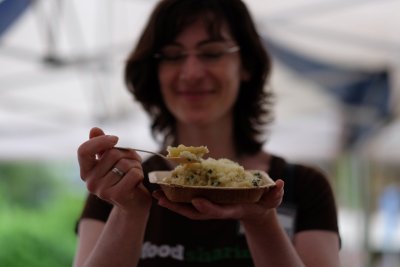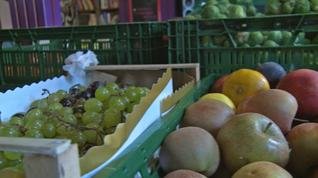Building a foodsharing community
Come gather 'round, people
Remember that the most important part of a sharing community is a community! Before you can actually start with any foodsaving, you will need to build up a reliable network of foodsavers. There is a lot of food to be eaten! So gather your trustworthy, dedicated friends and then reach out to local strangers and invite them to save food. Start an awareness raising campaign to get them on board:
- contact the existing alternative infrastructure like student committees, green offices, housing projects etc.
- publish an article in a local newspaper or give an interview on local radio
- get super active on social media to reach out even further
- organize info events and tell people about your plans

Together we are strong
There are many activities that can be set up to get to know each other and create bonds. Here are some ideas of events that we found relevant, fun, easy to organize and engaging:
- Food-Share Point construction workshop: if you want to set up a location where people can share food unconditionally, this can be a wonderful activity for members to connect.
- Brunch with saved food: if Sunday brunch is a thing in your town, there will surely be open-brunch cafés and restaurants who usually have a lot of yummy leftovers that can be saved. Get in touch with them, bring a lot of containers, from small to big, and save it! If you have access to a location nearby like a neighborhood center, a foodsaver's living room or a park in the warmer days, you can invite your whole community to join for a late and sustainable Sunday brunch :)
- Saving at festivals: Music festivals are a great saving opportunity, not only for food but for various items people leave behind there. It also is fun to go to a festival with your friends! So why not combine the two?
Of course it is as important to keep the people around as gathering them, so be sure to be nice to each other! If there are some who don't get what this means, you may want to refer to more clearly formulated criteria. In that case have a look at our guideline for positive cooperation (among the team members, in this case).
As big as possible while still managable
Some sort of membership control can become useful if your initiative grows fast. There are many ways to implement this and how you organize your rising network is completely up to you. For example, foodsharing.de has reached 17,000 volunteer members after 4 years of existence. Such a rapid growth is certainly a sign of good health, but it also meant introducing a selection process for membership. All people who want to join the German platform must pass a 10 minutes quiz which evaluates if they have understood the basic internal guidelines. This is to ensure that members are serious about saving food, know that they will have to spend time in doing so and really understand what the foodsharing philosophy is all about.

There's people on the internet
When starting to reach out and organize it can make sense to directly bring people together on an online platform. Karrot is the software we created for you to administrate your pickups. But it's far more than that! You can gather people in a custom group for your city way before you have your first cooperation, so that they are already there, when the time has come to really get started. Karrot groups are closed groups by default and new people need to apply to enter. This way you are free to implement whatever process you deem useful before welcoming new foodsavers into your group. Really, we encourage you to be creative, to think outside the box and come up with the best solution for your specific group! Feel free to get inspiration from others or come up with a whole new system. In the latter case, please let us know how it's working!
Friendly, connected and professional
For some behavioral standards example, please refer to the checklist 'Professionalism for foodsavers' within the cooperation mini manual.
However you choose to work together, the most important thing is, that you do. To make that possible it's important to stay in contact and to know where the other foodsavers are located. Karrot provides a map feature that gives a nice overview, if everybody signs up and enters their contact and location data. That way you can see who can help out where and in which parts of your area it makes sense to look for more cooperation partners. If for some reason Karrot doesn't work for you, you should still try to keep a secure database of your members with contacts and addresses, respectful of data privacy and protection laws.